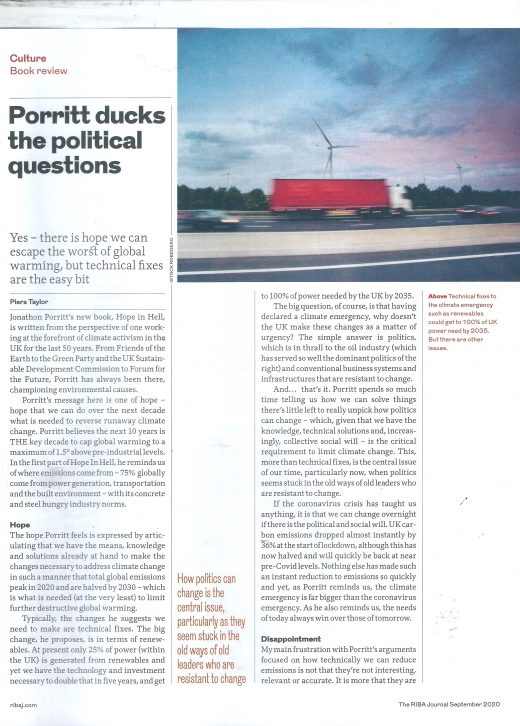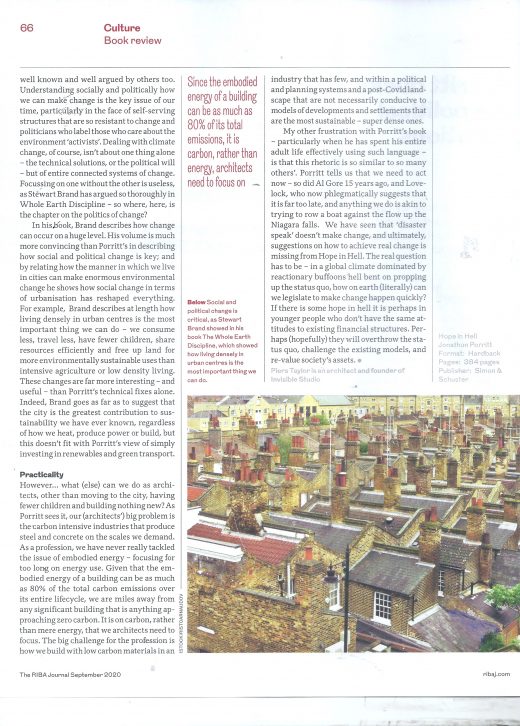Hope In Hell
Jonathan Porritt’s new book is written from the perspective of one working at the forefront of climate activism in the UK for the last 50 years. From Friends of the Earth, the Green Party, the UK Sustainable Development Commission to Forum for the Future, Porritt has always been there, championing environmental causes.
Porritt’s message here is one of hope – hope that we can do over the next decade what is needed to reverse runaway climate change. Porritt considers the next ten years is THE key decade to cap global warming to a maximum of 1.5 degrees above pre-industrial kevels. In the first part of Hope In Hell, Porritt reminds us of where emissions come from – 75% global emissions come from power generation, transportation and the built environment – with its concrete and steel hungry industry norms.
The hope Porritt feels is expressed via articulating that we have the means, the knowledge and the solutions already at hand to make the changes necessary to address climate change in such a manner that total global emissions peak in 2020 and are halved by 2030 which is what is needed (at the very least) to limit further destructive global warming.
Typically, the changes that Porritt suggest we need to make are technical fixes. The big change as far as Porritt concerned is in terms of renewables. At present only 25% of power (within the UK) is generated from renewables and yet we have the technology and investment necessary to double that in 5 years, and get to 100% of power needed by the UK by 2035.
The big question, of course in the UK, is having declared a climate emergency, why don’t we follow through and make these changes as a matter of urgency? The simple answer is politics, which is in thrall to the oil industry (which has served so well the dominant politics of the right) and conventional business systems and infrastructures that are resistant to change.
And… that’s it. Porritt spends so much time telling us how we can solve things without really unpicking how politics can change – which, given we have the knowledge, technical solutions increasingly collective social will – is the critical thing that needs to change for climate change to be limited. This, more than technical fixes, is the central issue of our time, particularly now when politics seems stuck in the old ways of old leaders who are resistant to change.
If the Coronavirus crisis has taught us anything, it is that we can change overnight, if there is the political and social will. UK carbon emissions dropped almost overnight by 36% at the beginning of lockdown, although this has now halved and will quickly get back to near pre-Covid levels. Nothing else has made such an instant reduction to emissions so quickly and yet as Porritt reminds us, the climate emergency is a far bigger one than the Coronavirus emergency. As Porritt also reminds us, the needs of today always win over those of tomorrow.
My central frustration with Porritt’s arguments which focus on how technically we can reduce emissions is not that they’re not interesting, relevant or accurate. It is more that they are well known and well argued by others too. Understanding socially and politically how we can make change is the key issue of our time, particularly in the face of self-serving structures that are so resistant to change and politicians who label those who care about the environment ‘activists’. Dealing with climate change, of course, isn’t about one thing alone – the technical solutions, or the political will – but of entire connected systems of change. Focussing on one without the other is useless, as Stewart Brand has argued so thoroughly – so where, here, is the chapter on the politics of change?
In The Whole Earth Discipline, Brand describes how change can occur on a huge level. Brand’s book is much more convincing than Porritt’s in describing how social and political change is key, and how social change in terms of urbanisation has reshaped everything in relating the manner in which we live in cities can make enormous environmental change. For example, Brand describes at length how living densely in urban centres is the most important thing we can do – we consume less, travel less, have fewer children, share resources efficiently and free up land for more environmentally sustainable uses than intensive agriculture or low density living. These changes are far more interesting – and useful – than Porritt’s technical fixes alone. Indeed, Brand goes as far as suggesting that the city is the greatest contribution to sustainability we have ever known, regardless of how we heat, produce power or build, but this doesn’t fit with Porritt’s view of simply investing in renewables and green transport.
Irrespective – what (else) can we do as architects, other than moving to the city, having fewer children and not building anything new at all? As Porritt describes, our (architects’) big problem is the carbon intensive industries that produce steel and concrete on the scales we demand. As a profession, we have never really tackled the issue of embodied energy – focusing for too long on energy use. Given that embodied energy over the whole life of a building can be as much as 80% of the total carbon emissions over the lifecycle of a building, we are miles away from any significant building that is anything approaching zero carbon. It is carbon, rather than mere energy, where we architects need to focus. The big challenge for architects is how we build with low carbon materials in an industry where there are few, and within a political and planning systems and a post-Covid landscape that are not necessarily conducive to models of developments and settlements that are the most sustainable – super dense ones.
My other frustration with Porritt’s book – particularly when Porritt has spent his entire adult life effectively using similar rhetoric – is that this rhetoric is so similar to so many others. Porritt tells us that we need to act now, and so did Al Gore 15 years ago, and so did Lovelock, who now phlegmatically suggests that it is far too late, and anything we do is akin to trying to row a boat against the flow up the Niagara falls. We have seen that ‘disaster speak’ doesn’t make change, and ultimately, suggestions on how to achieve real change is missing from Hope in Hell. The real question has to be – in a global climate dominated by reactionary buffoons hell bent on propping up the status quo, how on earth (literally) can we legislate to make change happen quickly? If there is some hope in hell it is perhaps in younger people who don’t have the same attitudes to existing financial structures. Maybe (hopefully) they will overthrow the status quo, challenge the existing models, and re-value societies’ assets.
Piers Taylor 2020

